1. Alkyl halides can undergo nucleophilic substitution or elimination reactions. Nucleophilic substitution reactions include SN2 and SN1 mechanisms, while elimination reactions include E1 and E2 mechanisms.
2. The type of reaction depends on factors like the structure of the alkyl halide, the nucleophile, the base, and the solvent. Primary alkyl halides favor SN2, while tertiary alkyl halides favor SN1 or E1/E2 in protic solvents.
3. The chapter examines these reaction mechanisms in detail to understand how they occur and how their characteristics can be used to predict and control reaction outcomes.
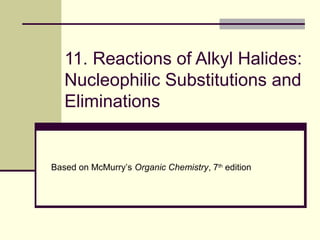
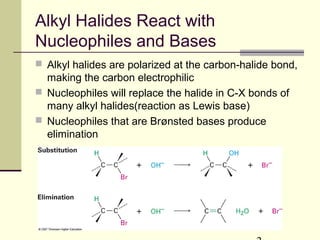


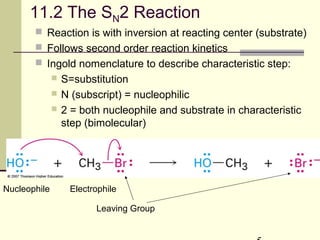
![Reaction Kinetics
The study of rates of reactions is called kinetics
Rates decrease as concentrations decrease but the
rate constant does not
Rate units: [concentration]/time such as L/(mol x s)
The rate law is a result of the mechanism
The order of a reaction is sum of the exponents of the
concentrations in the rate law
A + B -----> C + D
Experimentally determine the effect of increasing A/B
First Order: rate = k[A] (only depends on [A], not [B])
Second Order: rate = k[A][B] (depends on both [A],[B])
Third order: rate = k[A]2
[B]](https://image.slidesharecdn.com/chapter11-180308042043/85/Chapter11-6-320.jpg)
![SN2 Process
The reaction involves a transition state in which both
reactants are together
Rate = k[ROTs][OAc]
NucleophileElectrophile
Leaving Group](https://image.slidesharecdn.com/chapter11-180308042043/85/Chapter11-7-320.jpg)
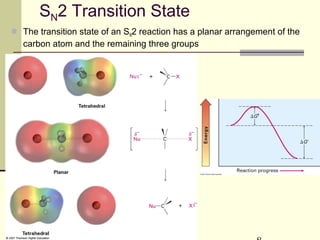








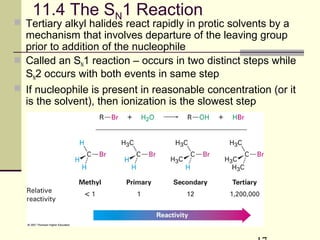
![SN1 Energy Diagram and Mechanism
Rate-determining step is
formation of carbocation
rate = k[RX]](https://image.slidesharecdn.com/chapter11-180308042043/85/Chapter11-18-320.jpg)








![11.8 The E2 Reaction
A proton is
transferred to base
as leaving group
begins to depart
Transition state
combines leaving of
X and transfer of H
Product alkene forms
stereospecifically
Rate = k[RX][B]](https://image.slidesharecdn.com/chapter11-180308042043/85/Chapter11-27-320.jpg)




![11.10 The E1 Reaction
Competes with SN1 and E2 at 3° centers
Rarely have “clean” SN2 or E1 single products
Rate = k [RX], same as SN1](https://image.slidesharecdn.com/chapter11-180308042043/85/Chapter11-32-320.jpg)


